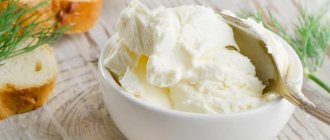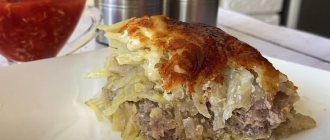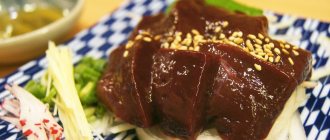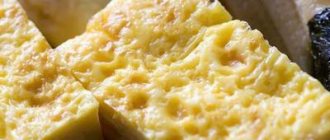Nutritional value and composition
Champignon is 80% water.
Another 20% are vitamins, organic acids and minerals. Table 1 “Chemical composition of champignons”
| Compound | Contents per 100 grams |
| Squirrels | 4.3 g |
| Carbohydrates | 0.1 g |
| Fats | 1 g |
| Water | 81 g |
| Ash | 1 g |
| Alimentary fiber | 2.6 g |
| Unsaturated fatty acids | 0.1 g |
| Saturated fatty acids | 0.1 g |
| Mono- and disaccharides | 0.1 g |
| Vitamins | |
| Vitamin A | 2 mcg |
| Beta carotene | 0.01 mg |
| Thiamine (vitamin B1) | 0.1 mg |
| Riboflavin (vitamin B2) | 0.45 mg |
| Pyridoxine (vitamin B6) | 0.05 mg |
| Pantothenic acid (vitamin B5) | 2.1 mg |
| Folic acid (vitamin B9) | 30 mcg |
| Vitamin PP | 5.6 mg |
| Vitamin E | 0.1 mg |
| Vitamin C | 7 mg |
| Minerals | |
| Calcium | 4 mg |
| Potassium | 530 mg |
| Sodium | 6 mg |
| Phosphorus | 115 mg |
| Sodium | 6 mg |
| Chlorine | 25 mg |
| Fluorine | 14 mcg |
| Iron | 0.3 mg |
| Iodine | 18 mcg |
| Zinc | 0.28 mg |
| Chromium | 13 mcg |
| Cobalt | 15 mcg |
| Molybdenum | 3 mcg |
| Rubidium | 26 mcg |
As you know, all mushrooms are rich in proteins. And champignons are no exception: 1 kilogram of this product contains approximately as much protein as 1 liter of cow's milk. Pecheritsa protein contains 18 amino acids, 8 of which are essential (they enter the human body exclusively with food and cannot be synthesized). Japanese researchers have found that champignons contain high amounts of amino acids such as lysine and arginine, which have a beneficial effect on the development of human mental abilities and memory. The protein of this mushroom is absorbed by 70-80%. Therefore, those who consume them can, without harming their health, give up sausages and meat.
Champignons are similar in phosphorus content to fish. Their chemical composition is quite large, and this distinguishes these mushrooms from others. They harmoniously combine vitamins, beneficial macro- and microelements. The caloric content is very low - 100 grams contain no more than 27 kcal.
Beneficial features
The health benefits of champignon mushrooms are provided by their chemical composition.
B vitamins
Vitamin group B takes an active part in human life:
- vitamin B2: is a participant in redox processes (ORP or ORP), acts as a regulator of color perception by the visual organs, provides dark adaptation (adaptation to vision in the dark), its deficiency affects the quality of the skin and mucous membranes, disrupts the quality of visual perception of light and twilight ,
- vitamin B5: takes part in the metabolic processes of proteins, carbohydrates, fats and cholesterol, with its help the synthesis of hormones and hemoglobin occurs, affects the quality of digestibility of amino acids and saccharides by the intestinal tract, provides supportive assistance to the adrenal glands, its lack causes a change in the integrity of the skin epithelium and mucous membranes.
Vitamin PP
Mushrooms contain vitamins necessary for humans
The vitamin component PP takes part in the energy-metabolic process; its lack causes a change in the qualitative characteristics of the skin epithelium, destabilizing the activity of the gastrointestinal tract and cells of the nervous system.
Potassium
Potassium is the main intracellular ion involved in regulating the balance of acid, water and electrolytes, serves as a conductor of nerve impulses and regulates blood pressure. For your information. Potassium is an essential component of the so-called. “sodium-potassium pump”, or “sodium-potassium pump” - an enzyme belonging to the group of transport adenosine triphosphatases, responsible for the transport of K+ and Na+ ions through the cell membrane.
Phosphorus
Phosphorus is a participant in most physiological processes, including energy metabolism and acid-base balance. It is present in the composition of nucleic acids and phospholipids necessary for the processes of mineral provision of bone tissue and tooth enamel.
Iodine
Iodine is an essential element for the normal functioning of the thyroid gland. It organizes the process of hormonal formation: thyroxine and triiodothyronine, necessary in the process of cellular growth and development, important for mitochondrial (intracellular) respiration and regulation of the transport of sodium and hormones. Its deficiency leads to a slowdown in the metabolic process, delays in development and growth.
Cobalt
The cobalt content ensures activation of the metabolism of fatty acids and folic acid. Cobalt is present in the vitamin B12 molecule, where its mass fraction is 4%. With a lack of this vitamin in the body, a person develops malignant (pernicious) anemia.
In addition, cobalt is characterized by an effect on:
- metabolism of carbohydrates and lipids;
- thyroid function;
- myocardial condition.
Chromium
The presence of chromium makes it possible to regulate blood glucose levels, causing an increase in insulin action. Its deficiency reduces the body's sensitivity to glucose.
A little history
The champignon is one of the first cultivated mushrooms. We owe its wide distribution primarily to the King of France, Louis XIV (1638-1715). He was a connoisseur of mushroom dishes and ordered his gardeners to “domesticate” meadow champignons. At first they were grown on lawns as seed, using mycelium that was collected in nature, and then collected from their beds.
At the end of the 17th century, it was noticed that pecheritsa could grow well in underground rooms and basements. Their cultivation in France reached its maximum development in the 18th-19th centuries, especially near Paris. This was facilitated by the presence of old quarries, in which throughout the year the temperature was in the range of 12-14 ° C, favorable for the cultivation of these mushrooms. Champignon culture from France penetrated into Germany, Great Britain and other European countries. Since 1903, they began to be grown in America.
In 1893-1894 in France, the Pasteur Institute developed a method for germinating champignon spores and obtaining sterile mycelium. In most countries where the culture of these mushrooms had already spread, by 1924 special laboratories had been developed where their sterile mycelium was produced. In Russia, champignons began to be bred starting in the middle of the 18th century.
Today, champignons are cultivated in more than 70 countries around the world. This industry is most developed in the UK, USA, Germany, France, Denmark, the Netherlands and other countries. About 25% of production occurs in the United States, which is also the main exporter of such mushrooms.
The largest plantation in the world is located in an old limestone mine in Pennsylvania. The underground galleries of the plantation are 24 kilometers long.
Cultivation of champignons
The reason for the widespread production of champignons is their abundant fruiting, excellent taste and unpretentiousness. In terms of their nutritional properties, cultivated pecheritsa are similar to wild ones, but their value is much higher. They can be grown all year round. Champignons bear fruit well in the dark due to the lack of chlorophyll in their tissues. Nowadays, the production technologies of these mushrooms have almost reached absolute automation. They are grown in specially equipped basements, greenhouses, and open ground. Champignons grown artificially are not capable of polluting the external environment. Modern technologies make it possible to prevent the penetration of toxic substances, bacteria, and protein breakdown products into the mycelium.
Biological features and distribution
Champignons grow in moist soil with rich organic humus. Some types of these fungi are found on anthills and tree bark.
There are several main groups of champignons:
- forest ones, which grow on the edges of forests;
- soil, which grow in non-vegetated spaces;
- herbophiles grow among herbaceous plants;
- desert or halophytes.
The largest number of such mushrooms grows in the steppes and forest-steppes of Europe, as well as in the prairies of Australia, Africa and North America.
The champignon cap is massive and dense, covered with scales and has a color from pure white to brownish. The plates of the mushroom are white, but over time they darken to pinkish and gray. The stem of the mushroom is dense and smooth, and the flesh can have a white, reddish or yellowish tint.
For the first time, champignons were grown artificially in Italy. In the 17th century in France, these mushrooms began to be actively grown in basements and various underground rooms.
Currently, champignons grow throughout Europe, North America, Africa, Australia and some Asian countries.
Purchase and selection
Fresh champignons can be purchased in stores and markets. When choosing, you need to pay attention to the following criteria:
- fresh mushrooms are white, sometimes with a pinkish or beige tint;
- matte surface of the cap;
- absence of dents, dark areas or stains on the surface;
- the damaged integrity of the film connecting the stem and cap indicates the “old age” of the mushroom;
- smell the mushroom - its freshness is indicated by a pronounced pleasant smell that resembles anise;
- fresh champignon is elastic to the touch, but spoiled one is like a sponge.
Storage conditions
Let's consider different options for storing champignons.
- Opened mushrooms can be stored in the refrigerator for up to 2-3 days - not covered with film, they become airy and begin to darken. Under cling film, the shelf life is extended to 5-6 days. If stored for a longer period of time, they can harm the body.
- To increase shelf life, champignons are frozen. In this form they can be stored for a very long time, but defrost them in portions - they should not be allowed to re-freeze. To freeze fresh mushrooms, you need to wash them well, dry them, and if necessary, cut large ones into pieces and trim off the excess. After this, freezing is carried out. Store them in tightly tied bags.
- You can freeze pre-fried champignons. To do this, add oil to a deep frying pan and fry until the moisture evaporates or put it in the oven without oil. Then the fried mushrooms are placed in a container and frozen. They can be stored in this form for no more than 6 months.
- The champignons are washed and boiled in lightly salted water, cooled, dried thoroughly, placed on foil or a baking sheet in one layer and frozen. Shelf life - no more than six months in tied portion bags.
Champignons and weight loss
Due to their low calorie content, mushrooms are often included in dietary dishes.
Due to their high protein content, champignons can replace higher-calorie meat products, which is important for people who fast or prefer vegetarian diets. In terms of the amount of phosphorus, champignons are not inferior to some types of fish, and in terms of vitamin composition they are close to grains and vegetables.
The dietary fiber contained in mushrooms is slowly digested in the stomach, causing satiety even after a small portion, which leads to a decrease in the amount of food eaten per day.
When including champignons in the diet, observe the following rules:
- do not consume more than 300 grams of mushrooms per day;
- do not combine food with nuts, dairy products and fruits in one meal;
- to reduce the calorie content of dishes, steam, boil or stew them with a minimum amount of fat;
- fry mushrooms in non-stick pans without using oil.
Fresh champignons can be kept in the refrigerator without losing their beneficial and nutritional properties for no more than 4 days, and at 100C - no more than 12 hours. If you plan to store mushrooms longer, it is best to wash and freeze them.
The greatest amount of useful substances is found in young, small-sized mushrooms. When purchasing, you should pay attention to the appearance of the champignons: freshly picked mushrooms will have smooth and even skin on the cap without spots, wrinkles or shrunken areas. The color of the mushrooms depends on the variety and can be white, cream or brownish-brown.
Use in cooking
Champignons are widely used for preparing a variety of dishes, pickled, dried, frozen or fried. They are baked in clay pots, added to salads, soups, snacks, baked goods (as a filling for pizzas, sandwiches, zraz, pies), stewed in sour cream or various sauces. Young mushrooms are often eaten because they have the most delicate taste. In cooking, more than 200 dishes can be prepared from them.
Champignons go well with vegetables, seafood and fish, meat, cereals, eggs, and cheese. Many people like stewed potatoes with champignons, but, according to nutritionists, mushrooms and potatoes do not go well together, just like with nuts and milk: dissimilar proteins, high glycemic index of starch - as a result, digestive upset is possible.
Before cooking, the mushroom must be cleaned of soil and other contaminants. First, use a knife to clean off the dirt and quickly rinse the champignons under running water. It is not recommended to leave them in water for a long time, otherwise the mushrooms will become tasteless and watery. When cleaning, the film that is located between the cap and the stem is removed. The bottom of the leg is cut off if it is dirty.
Although champignons can be eaten fresh, in most cases they are eaten after short-term heat treatment. Champignons that are grown industrially are more widely used because they tolerate any type of cooking well. Wild ones are well suited for fillings, sauces, and first courses. But they are not suitable for frying - they will become very hard and dry.
How to choose the right champignons
Remember one single rule - never buy champignons at spontaneous markets, from hand, and do not collect them in the forest/fields. The fact is that mushrooms absorb as much as possible all harmful substances and poisons/toxins from the earth and air. And, according to scientific research, young champignons have all the properties of toadstool. But mushrooms grown in artificial conditions, special greenhouses, are absolutely safe - they can be safely eaten.
To ensure your purchase does not disappoint, follow these recommendations::
- the color of a quality mushroom should be white or with a slight pinkish tint;
- If the mushroom has acquired a brownish tint, this means that the champignon is overripe. This does not make it poisonous, but the taste will be significantly reduced;
- The product in question should not have any sour odor;
- the leg of a fresh champignon should not fall off “in your hands”;
- the lower membranes on the cap of the mushroom in question should not crumble.
The shelf life of champignons is very short - if immediately after purchase you put them in a container and put them in the refrigerator, then the shelf life is limited to 5 days.
You can wash the purchased champignons thoroughly, dry them and freeze them - the shelf life increases 50-70 times, but at the same time the taste is somewhat lost.
It is not recommended to thoroughly wash champignons or keep them in water for a long time - these mushrooms absorb a lot of moisture and lose all their quality characteristics. It would be better if the purchased mushrooms are peeled with a knife (a thin layer of peel is removed) and then washed in running water - this will be quite enough.
Champignons are a very tasty and even very healthy product. You just need to know in which cases it is better to limit the amount of consumed mushrooms of the type in question, and in which cases to completely exclude them from the menu.
10, total, today
( 169 votes, average: 4.62 out of 5)
Dogwood: benefits and harm
Watermelon: benefits and harm
Related Posts
Medicinal properties
Champignons have medicinal properties. They have found their application in folk medicine and dietetics.
- The low calorie content of champignons allows them to be used in various diets for weight loss, without depriving yourself of essential vitamins and other beneficial substances. Due to its low sodium content, it is successfully used in salt-free diets.
- Such mushrooms can be eaten by diabetics - they contain no sugar and virtually no fat.
- Champignons have the ability to cleanse the body by removing heavy metal salts.
- They contain aromatic and flavoring extractive substances, which in the body cause the release of digestive juices in abundant quantities, improve the absorption of food and stimulate appetite, and enhance metabolism.
- Due to its expectorant and bronchodilator effect, it can be used for the complex treatment of bronchopulmonary pathology (bronchial asthma, bronchitis, etc.).
- Can lower cholesterol levels and prevent the formation of plaques. Studies have shown that people who often consume these mushrooms have 34% lower blood cholesterol levels compared to those who do not eat champignons. Therefore, the risk of heart attack and atherosclerosis is reduced.
- Due to the high content of riboflavin and thiamine, the use of pecheritsa helps prevent headaches and migraines.
- Helps get rid of psoriasis, eczema, ulcers, purulent skin lesions.
- Slows down skin aging - can be used to make masks.
- The healing properties are also preserved in dried mushrooms. They should be consumed by those people who suffer from stomach ulcers and hepatitis.
Contraindications
Despite the usefulness of champignons, there are contraindications to their use:
- It is not recommended for consumption by patients with chronic kidney and digestive diseases.
- The high content of folic acid in mushrooms promotes the growth of malignant cells and their reproduction, so cancer patients should not eat champignons.
- You need to be careful with such mushrooms when breastfeeding and pregnancy.
- Children under 5 years old should not eat any dishes with champignons, even if it is only, for example, a topping on pizza or pies, since their bodies do not have enough enzymes necessary for their digestion.
Champignon is an amazing mushroom that is rich in vitamins and minerals. It is not only an excellent nutritious product, but also has many beneficial properties, thanks to which it is widely used in cosmetology, dietetics and folk medicine.
More fresh and relevant information about health on our Telegram channel. Subscribe: https://t.me/foodandhealthru
We will be grateful if you use the buttons:









